Search the Community
Showing results for 'meantone'.
-
Do these Jeffries buttons make sense?
Alex West replied to Andy Holder's topic in General Concertina Discussion
Andy Your Bb/F doesn't conform to a "standard" Crabb/Jeffries 38 (or 39) key layout, but then most of such instruments I've come across have deviated in one or two places, either as originally built or as a result of previous owners modifying them to suit their playing requirements. Some of the accidentals on yours make sense, for example to give note options in both push and draw, but others don't make much sense; for example on the left side, I can't see a reason why anyone would need 3 Bb3 notes all on the push and 2 Ab4 on the push. The thumb button doesn't conform to either of the "standards". It neither functions as a drone, nor does it give the useful Bb3 on the draw and the Eb on the push. The Eb is available elsewhere, but I can't see the need for the G3. However, the specifier must have liked his "G"s to have the G2 down at the bottom. On the right side, the story is similar - why have 3 B5 notes all on the push? Why have 2 E5s on the draw, one of them in an awkward place? Why have 2 A4s both on the draw, both playable by the same finger? Some of the peculiarities may be explained by the original tuning being a meantone (which you've covered in another post) where 2 ostensibly similar notes were actually 50 cents or more apart to avoid the wolf notes in particular keys? I'd imagine that it's possible to swap some of the notes around to get more of a standard layout and make more sense of the duplicates but I'd suggest you leave that to the buyer. One other point; you've highlighted in yellow some notes which were added to the standard 38 key layout; look carefully at the chart I sent you in a PM - you'll see that a couple of these yellow notes are in the correct position for a 38 key. Best of luck Alex West -
The trick for playing the fiddle "in-tune" with these different Temperaments; My wife,who never uses an electronic device for tuning her fiddle anyway, tunes her open strings, by ear, to those notes of my Concertina. This is the same method she uses when I play the Pipes. In this way those notes that cannot be pulled in by fingering are in tune. One of my pet-hates are those who arrive at a music session and proceed to tune their instruments to an electronic tuner.... this is pure musical ignorance! However, it does sound as if you are getting along well with Meantone, Chuck, I'm glad of that. Geoff.
-
I hope to be able to add some direct experience shortly; Greg Jowaisas is just wrapping up the restoration of a mid-1850s Wheatstone for me. It is still in the original high pitch meantone, and he's restoring it to the original condition (complete with the original bellows).
-
Thanks for the positive comments Andy,Blue Eyed Sailor and Mike, I'm glad that you found the explainations interesting. Perhaps many of us that are involved with playing 'Folk Musics' might question the usefullness of these alternate tunings. So, I might suggest two absolute opposite cases where deviations from Equal Temperament are used. The first is with early keyboard music . One CD that I listen to very regularly is Christopher Hogwood's 1983 recording of J;S.Bach's "French Suites" for Harpsichord. For each of the six suites Hogwood chooses a different temperament, including twice using the 1/5 Comma Meantone each with slight variations to suit the keys of the pieces but does not use ET at all. The other very different case is the tuning system used at the pure end of Irish Piping. On the Uilleann pipes the notes of the chanter should be able to make a complete set of PERFECT intervals to the drone pitch. That means each interval is the most pleasing to the human ear and includes all intervals both major and minor. In practice this is very difficult to achieve especially if one also wishes to provide the musician with enough tones that are as close as possible to Equal Temperament for playing with other instruments. Quite a few of the perfect interval notes are a long way from their ET equivalents and this can cause problems musically when playing with others unless the other instrument(s) are as tunable as a fiddle. It is possible to set the notes of a concertina so that they agree with those of the pipes but a fine piper will use several variants of pitch on some notes and each piper may well have their own idea as to where to place these notes on the scale.... one example of this is ; if we say that the drone note is D (that is what Irish pipers call it) then the perfect Second (E) will have two positions , Major Second 204 cents sharper than the D and a minor Second 190 cents sharper than D.... This is just to suggest that not everyone uses Equal Temperament . And so it goes on and opinions differ. Cheers, Geoff.
-
This dates back to the days before Equal Temperament became the norm in the concertina world, when G#/Ab and D#/Eb were different notes by about 20 cents (there are 100 cents in an interval). Meantone Temperament was used for English concertinas at least through the 1860's, maybe longer? I was surprised to find out my Bastari Anglo from the 1970's is in Pythagorean Temperament. Cajun accordions use a completely different temnperament system as well. So, to answer your question, if it's an English concertina in Equal Temperament then the G#/Ab and D#/Eb will be exactly the same and you can call them whatever you like depending on the proximity to the non-sharped or flatted note, or depending on the key signature of the music you are playing. Since they are now the same, you will sometimes see the extra one omitted on cheaper EC's with fewer buttons. Gary Thank you Gary. That was a very clear and logical explanation. I generally tune to equal temperament so it doesn't really matter but it was more a curiosity as to why some reeds were stamped G# and some stamped Ab. All is now clear, thanks. Andrew
-
This dates back to the days before Equal Temperament became the norm in the concertina world, when G#/Ab and D#/Eb were different notes by about 20 cents (there are 100 cents in an interval). Meantone Temperament was used for English concertinas at least through the 1860's, maybe longer? I was surprised to find out my Bastari Anglo from the 1970's is in Pythagorean Temperament. Cajun accordions use a completely different temnperament system as well. So, to answer your question, if it's an English concertina in Equal Temperament then the G#/Ab and D#/Eb will be exactly the same and you can call them whatever you like depending on the proximity to the non-sharped or flatted note, or depending on the key signature of the music you are playing. Since they are now the same, you will sometimes see the extra one omitted on cheaper EC's with fewer buttons. Gary
-
Yes leave it as it is, let the buyer decide. I have a strong suspicion that some Jeffries concertinas in BbF had the reed shoes marked for CG from new. Especially likely if it is still in what could be Bb/F old high pitch. Also worth checking to see if it is ET or meantone. People do still want BbF concertinas and they are getting harder to find also the Irish market for CGs has weakened a huge amount so the difference in saleability is now small.
-
Dave, You've lost me. You're not talking about a microtonal system of 14 evenly spaced notes per octave, are you? If so, was there really an instrument from the mid 1850's in that tuning? It boggles the mind. Could you expound and expand on this? I'm a big fan of microtonalism, but I haven't run across qnyone using 14. 15 and 19 per octave are in use - but it's an acquired taste. I knew Ivor Darreg when he lived nearby and visited his home, where he had a mad collection of perfectly tuned pipes, bells, and fretted stringed instruments in different microtonal systems. Ken No, not 14 evenly spaced notes per octave. A meantone system in which D# and Eb are not the same note. This is possible since the English Concertina actually has different buttons for D# and Eb. I think the most knowledgeable person on Concertina.net on the subject of non-equally tempered Concertinas is Paul Groff. --Dave
-
Hopefully very shortly I will be playing both; although one of the will not be a "playing with others" instrument. Greg Jowaisas is restoring an instrument from the mid-1850s for me that appears to be in original high pitch meantone tuning, and keeping it in that tuning. I want to play with 14 notes per octave, and fancy an instrument that was originally in that tuning over a newer one that was placed into it. This also keeps my streak of "well, sure, you can have a go, but I don't think it plays the way you're used to" concertinas...
-

My first days with an English Concertina
Dave Weinstein replied to Lawrence Reeves's topic in General Concertina Discussion
As seen in the Restoration thread, I will be getting a meantone English this year. I expect to not use it for Irish music (I already have instruments built for that) but rather to play other styles of music, and to play with thirds that don't drive me crazy. -

Dapper’s Delight: new CD – INDOORS
Geoff Wooff replied to adrian brown's topic in General Concertina Discussion
My copy has just arrived! Not only would Dapper be delighted but I am also. This is a fine direction in which to take one's Concertina playing. With exquisite performances by both Susanna and Adrian I highly recomend it. It is also interesting to note that two of Adrian's Anglos are tuned to '1/4 Comma Meantone Temperament'... for which I have long been an advocat. I usually tune my Englishes like this too, only with a small compromise towards Equal Temperament (called 1/5th Comma) so that playing with other instruments in 'normal' ET does not cause too many note clashes. So, another fine addition to the recorded Concertina. Congratulations and thanks, Geoff. -
DAN: As Stephen pointed out, things were not as simple back in the nineteenth century. Note the following, however: (1) a Wheatstone price list from the 1910s says that unless otherwise ordered, the concertina will be tuned to c'' = 540Hz, which puts the a' (the note that the oboe player sounds when the orchestra tunes up) at 452.5Hz; (2) a' = 452.5 was the tuning that the piano manufacturer Broadwood used from at least 1852 to at least 1874; it was also the frequency to which the Philharmonic Society Orchestra tuned most often (both Broadwood and the Phil Soc Orch were in London); (3) a study that's still very useful is Alexander John Ellis, "The History of Musical Pitch," Journal of the Society of the Arts, vol. 28 (1880); this has been reprinted in Studies in the History of Musical Pitch: Monographs by Alexander J. Ellis and Arthur Mendel (Buren [NL], 1968); note that Ellis himself played the concertina (he is listed in the Wheatstone ledgers), and actually had an instrument specially tuned to "just" temperament for him by Lachenal. Allan P.S.: Not only were there a number of different tunings in use at the same time (in terms of the frequency to which this or that note was tuned), but there were also different TEMPERAMENTS in use. Note that equal temperament (to which we are accustomed and in which all half-steps are equidistant from one another [100 cents], so that all keys sound the same), was slow to become the norm in England. The Broadwood piano company adopted it as their customary temperament only in 1846, and many an English church organ was re-tuned to it only later. Until that time, the situation is rather precarious. Some instruments were no doubt tuned in MEANTONE (the concertina was so tuned until [probably] the mid- to late 1850s, when the nature of the music that was being written for it would not longer have been playable in meantone, especially against an equal-tempered piano); other keyboard instruments, though, were probably tuned in one or another of the various WELL TEMPERAMENTS, with Thomas Young's well temperament No. 2 perhaps having been particularly popular. All in all, it is a hornet's nest, about which a gentleman in Bristol named Alexander Mackenzie of Ord has done important research. I write about the entire problem (though somewhat briefly) in a forthcoming article titled: "The Victorian Concertina: Some Questions about Performance," which, if everything goes right, will appear in a new journal called Nineteenth-Century Review, vol. 2 (2005).
-
Morris Music On A C/g Anglo
Paul Groff replied to Peter Brook's topic in General Concertina Discussion
Stephen, As you probably know, another occasional contributor to this forum now owns at least one of the Jeffries concertinas you mentioned and I have heard a tape of him playing it. It really is a beautiful sounding instrument, although it may have been retuned since you heard it. I also have a special appreciation for high-pitch Bb/F anglos. It is really a shame that so few are left in their original keys and pitch. If I am not mistaken, the Free Reed recording of John Kelly, sr. features him playing one in this key, possibly loaned to him for the recording. In telephone conversation with me, the late Paul Davies also described his most original Jeffries anglos as being tuned "in mean-tone." As has been discussed in this Forum, it is pretty well-known that the early english concertinas were tuned in meantone. Of course, the term "mean-tone" really refers to a whole family of temperaments (e.g., 1/4 comma, 1/6 comma, "irregular meantone temperaments," etc. -- see "Tuning" by Jorgenson, among many excellent references). However, (as I think you and I discussed on the phone a few years back) I have seen quite a bit of evidence that at least some Jeffries anglos (as well as original anglos by Jones, John Crabb, etc.) were tuned to a much more unique system than any mean-tone tuning that I have seen documented for keyboard instruments, one that uniquely fits with the note layout of the anglo and its options for harmony, and that implies a playing style a little different from that usually used today. I am trying to finish a short, preliminary paper on my observations of the 19th century anglos I have been able to study that retain mostly original reedwork. I welcome any relevant information from you or other concertina tuners and historians. I don't want to re-invent the wheel if others have done this work (of documenting the ingenuity of the 19th century anglo tuners in London), and of course I will acknowledge all the help I receive. Paul -
This is in fine original condition, never restored, the only new things are the thumb straps. My only Concertina for a ten year period after I purchased it from Stephen Chambers in 1999.Number 30790. Currently tuned to 1/5th. Comma Meantone (A=440hz.) but I could tune it to Equal temperament if a purchaser so desired. Plays very well with a good tone. In its original box. Price €1500. Donation to C.net if sold here.
-
Wes, Thanks for the clarification. I was exploring your suggestion (in the original topic) that riveted reeds might have changed to screwed reeds between #21445 and #22961. From your answer above, and the limited evidence collected in these two topics, that seems a possibility but maybe only a possibility. Thank you also for the additional quotes. I don't think I have ever seen an octagonal pinhole concertina. It's very interesting to have all this information together "on the desk!" Goran, If I undstand you correctly, your three pinhole instruments all have riveted reeds and the three I have had a chance to study all had screwed reeds... a strange coincidence? I have seen the riveted reeds in rosewood, metal-button Wheatstone english concertinas from this period and I do like them. I think they have a very beautiful quality of tone. I don't have one to re-examine now, but I think the fitting of tongue to frame was not as precise as in the screwed-note reeded pinhole concertinas, and that the tongues were set (and needed to be set) a little high to work at their best. Both these features might be expected to very slightly slow the "attack" of the reed (or to necessitate a higher bellows pressure to achieve fast attack). But the riveted-reed instruments I have seen had all been repitched by other dealers or repairmen, and may not fairly represent the condition, response, and tone of these reeds when they left Wheatstone's shop. I remember doing a lot of re-adjusting of these to get them working better. And, of course, I'm not a serious player of the english concertina so I always defer to those who can operate the instruments better when considering which characteristics of reeds (etc. ) are more desirable. My speculation about temperament could be expanded as follows: Certain harmonies (especially major thirds and minor sixths, very common in the 19th century concertina literature) can sound much harsher in equal temperament than in the earlier meantone - (and possibly well-) temperaments. This is because of the "beating" effect caused by a dissonance between the higher harmonics of the two or more notes making up the harmony. In english concertinas tuned in equal temperament, if you play major third intervals in the mid- to upper register of the instrument you can generate some extremely ugly effects, including clearly audible, out-of-tune, "combination tones." These "combination tones" are audible at the frequencies corresponding to the SUM and (more importantly) the DIFFERENCE between the frequencies of two close, but not identical harmonics. I was wondering (again this is a question, not a conclusion) if the "pinhole" fretwork with its attenuation of high harmonics (and thus, of the beating and the combination tones) might be a response to complaints that harmonies on the concertina had become harsh since the switch from meantone. Alternatively, the development and utilization of the "extended treble" concept may have led to a demand for a sweeter tone on those very high notes (even when playing unharmonized melodies). This was my other speculation/question. I think these two questions can best be answered by the serious players of this instrument, those who have historical documents available, and perhaps the makers -- or all three working together. I'm just a tuner and anglo player! Paul
-
I've been collecting these for a while. Some newer additions. Carroll Concertina Carroll Bb/F C/G Anglo Concertina by Wally Carroll Collin Dipper English Elise German 20 b G/D with double reeds Herrington C/G 30 Button Jackie http://www.youtube.com/watch?v=Pfof7PP9r58&fmt=18 Koot Britts http://www.youtube.com/watch?v=rsoEpNKAFJs&fmt=18 Jeffries Concertinas: C/G / G/D {old pitch} & Bb/F! http://www.youtube.com/watch?v=MnKmqqeqIhw&fmt=18 3 Jeffries & Wheatstone Concertinas http://www.youtube.com/watch?v=ybkjZ0SEsy4&fmt=18 Lachenal 30 key anglo http://www.youtube.com/watch?v=pGqrQqxx9LM&fmt=18 http://www.youtube.com/watch?v=FLP-Hazx4Fg&fmt=18 Lachenal Ab/Eb Anglo concertina http://www.youtube.com/watch?v=acxSP5baJ9Q&fmft=18 Morse Ceílí http://www.youtube.com/watch?v=LihzKtyiVWs&fmt=18 Stagie D/G http://www.youtube.com/watch?v=pmhFBOfnqQ8&fmt=18 Stagi Hayden Duet http://www.youtube.com/watch?v=qAX7Jcv9tQ8&fmt=18 Wheatstone English with meantone tuning http://www.youtube.com/watch?v=AOgcREsjIyI&fmt=18 Wakker WA5 40 button anglo http://www.youtube.com/watch?v=IEuGGt7DuO0&fmt=18 http://www.youtube.com/watch?v=63u6LUDw7zs&fmt=18 Thanks Leo
-
Csfri's Public-domain Library: Free Download?
Paul Groff replied to James Plamondon's topic in General Concertina Discussion
Once again I have to correct my own posting... not only did I mistype "fifths"above but did not make clear that there really is no "circle of fifths" in meantone. The narrow meantone fifths make not a circle but a spiral after twelve tones, which is why D# is not Eb, G# is not Ab, etc. I should have referred to a series or chain of fifths. The "circle of fifths" is another one of those musical concepts many of us learned early but that are embedded within the concept of equal temperament (there is also a circle of fifths in well-temperament). -
Thanks Sam! the mellow sound is because of the beautiful voice of my Jacinta, she has a bit special tunning, the name is 1-5 comma meantone, as Geoff Woof told me. And the speed maybe is a bit excessive, I would have made less mistakes if I had played the tune a bit slower... sometimes when I play it alone I get it better, but I was getting tired of repeating the recording! Fernando
-
Dave, not sure what you mean. It is a square-ended wooden-ended one (one of two "Harley" lookalikes he has built), in CG, and I asked him to tune it to Meantone (I had built myself a CG a few years earlier and tuned it myself to Quarter Comma MT, and liked the sound). It has a peculiar reedy tone, probably the result of both the wooden ends and the square shape--it doesn't at all sound like his standard ones. Kind of like a German concertina with a much better action. Someone else on c.net has the other Harley-type; I cannot remember who. It isn't you, is it? Cheers, Dan
-
I looked again at the chromatic scale of the EC and the enharmonics that exist in equal temperament (ET), and which of the scales could be played in meantone temperament (MT) without resorting to the buttons that in ET are enharmonic equivalents. This is a map of all the notes that may be tuned in MT: | Bb Db Eb Gb Ab |A B C D E F G | A# C# D# F# G# The MT notes marked in blue are not present on the EC. This means that the following major keys (and their relative minors) may be played in MT without resorting to any of the enharmonic notes (in ET) C, G, D, A, E, F, Bb, Eb Which for the music I play should be fine. Should I be concerned about modulating from # to b keys during the course of a piece - it certainly exists in the dance music that I play, but not in any of my current song repertoire. But then I don't envisage using this instrument for playing for dance; it is more suited to song accompaniment I feel.
-
I'm not sure what you mean - surely the wolf is still there (but possibly slightly better hidden), because if you need to use a D# you _need_ to use a D# (-12) and if you then need to jump to an A# you're forced to jump to a Bb (+10) and that interval is going to be pretty bad. When I eventually get around to getting my concertina tuned, I'd be much more inclined to consider one of the "well tempered"/unequal temperaments - either Vallotti or Bach/Lehman (described here)... Well, yes there are allways compromises in these systems even in Bach's proposals unless we have a keyboard with many more alternatives . In the one you point out it might be necessary to use the Eb before moving to the Bb unless the unusual interval does not bother the player/listener. I have,somewhere, a CD of a famous Harpsicordist who changes temperament for each of his recorded Bach suites so as to avoid these problems. Maybe some of us would then need several Concertinas in various tuning systems to satisfy our ears. There are no Wolf Fifths in a direct line through the cycle with these Meantone's temperaments but, as you point out ,if one has to move from sharp keys to flat keys to improve a bad interval then a degree of 'wolf' will be percieved at some point. However I think you could well be right? I must study this further.
-
Hi all i would like to hear answers on this question. I am quite convinced that there must be a traditional way of tuning concertinas by tuning this two additional notes slightly different. The only question that remains is on with button (note) the did start to tune, tuning perfect 5ths and perfect 3rds. This leads to a tone net with pure 5ths and 3rds. Meantone is not needed because it is possible to stay with this pure intervals on the preferred scales one uses on this instrument. If there is no information about the tuning technique one needs to no the scales that one likes to use. I have no experience with concertinas, but i would think there must be more as i ever did find about it. Best regards Johann Pascher
-
How many of the drawbacks to Meantone are mitigated by the fact that the English Concertina actually has 14 notes per octave, instead of 12?
-
Was that table of ratios the entire book? In fact, I suspect that the table is information which Berg and Stork themselves copied from elsewhere, since I believe meantone tuning would have been in use before either was born.



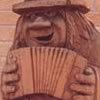
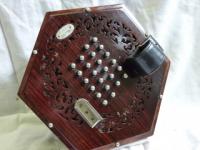
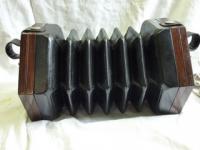
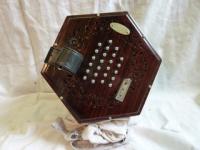
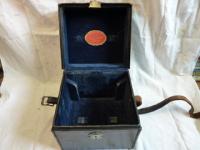


.thumb.jpg.e5ef9a111c1064c0bbea848f22aab7fe.jpg)
